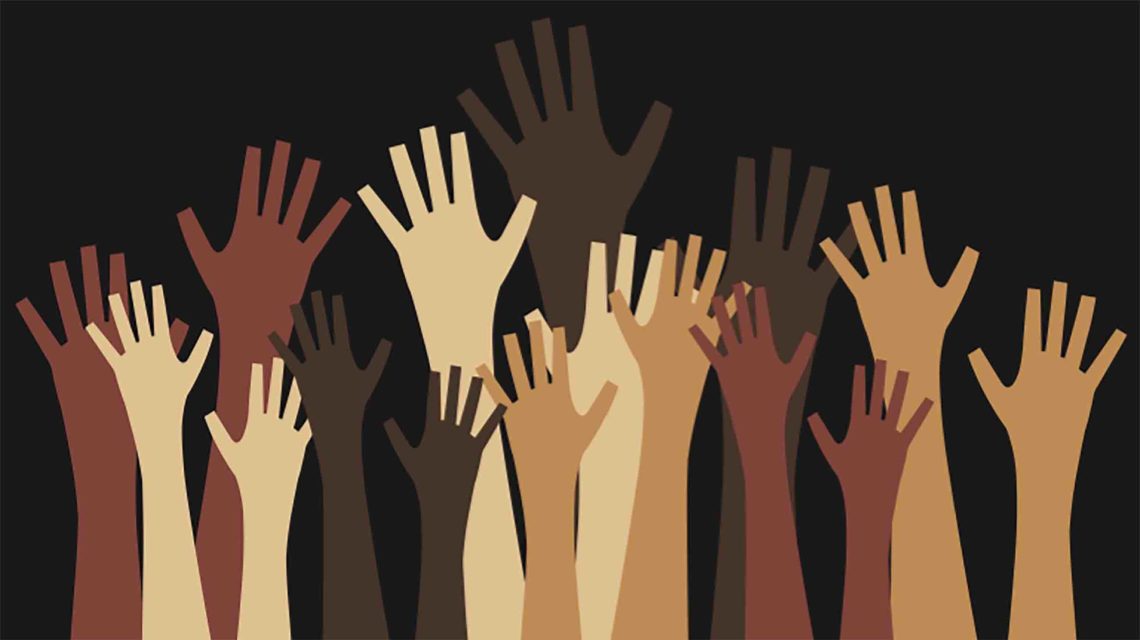By Lesley Evans Ogden
UnDark, November 6, 2017 —
Leaders of diversity programs argue that providing mentorship and ongoing career guidance is key to keeping minorities anchored in research fields.
It was 1993 when, from the podium at the banquet of the Animal Behavior Society’s annual conference, newly elected President Zuleyma Tang-Martinez remarked in her address that there were “too few brown faces” in the audience.
“I remember being shocked by that statement, most simply that someone would bring it up,” says Peggy Hill, an ecologist at the University of Tulsa. It was the first time Hill, who is white, had ever heard race and ethnicity mentioned among the society’s members, and as a multiracial member herself, Tang-Martinez, now a professor emerita at the University of Missouri-St. Louis, said she had seen only a handful of ethnic minorities over decades of ABS meetings.

This lack of diversity is a longstanding problem, not just in the field of animal behavior, but across the sciences in general. The National Science Foundation recently issued $8 million in grants to fund projects with a focus on diversity and inclusion. This comes on top of hundreds of millions of dollars committed by the federal government to promote diversity in science, technology, and engineering fields over the last decade. And while there have been modest increases in minority participation, the numbers remain staggeringly low.
According to 2010-2014 Census data collected by the National Science Foundation, 64 percent of the male population in the United States is white. Non-white Hispanics account for 17 percent of men, while 12 percent are black, and 5.5 percent are Asian, with smaller percentages accounting for other backgrounds. The numbers are similar for women.
Against this backdrop, the representation gap among tenured scientists employed at U.S. universities and four-year colleges becomes clear.
Among male scientists of such status, nearly 80 percent are white, according to 2013 data. Asians make up another 12 percent of male scientists, while blacks, Hispanics — and indeed, all other backgrounds — account for less than 5 percent each. Most female scientists are also white — 81 percent — with Asians accounting for 9 percent of women scientists, and blacks and Hispanics accounting for 4 percent each.
It was with numbers like these in mind that Hill, along with Tang-Martinez and others, launched the Charles H. Turner Program in 2002.
Named after one of the first African-American researchers in animal behavior, the program’s original aim was to increase participation at society meetings by undergraduates from visible minorities. But as explained by Tang-Martinez, who now serves as the society’s historian, the program today defines minorities more broadly, to include the LGBTQ community and those experiencing disability.
Initiatives like this one aim to support the careers of minority scientists — in part by getting them to the professional networking and educational events that are so often out of reach. The thinking behind such programs is that encouraging interest in the sciences is not enough, and that providing mentorship and ongoing career guidance is key to keeping minorities anchored in research fields — and the communities that grow up around them.
“It was really overwhelming,” recalls Delia Shelton, a postdoctoral fellow in biology at Oregon State University who was among the first Turner awardees back in 2005. Turner fellows assembled for professional development talks about meeting etiquette. They also received advice on giving poster presentations, and learned more about how to get involved in the Animal Behavioral Society, apply to graduate school, and locate funding. But the most special thing to Shelton was being paired with a mentor. “That person served as a gatekeeper to the society,” she says. “They were there every step of the way introducing us to their colleagues. It really broadened my network and it made the meeting feel smaller.”
Her mentor was Jeff Lucas, an older white male. “I had no idea who Jeff was,” Shelton laughs. She soon learned he was an expert in bird communication at Purdue University. “He didn’t try to persuade me to go and study birds at all,” says Shelton, who is now studying, among other things, social networks in fish. Lucas sat down with Shelton to talk and helped connect her with colleagues. Shelton tagged along with Lucas to plenaries and lunches, getting the low-down on the field’s scientific controversies.

Delia Shelton, PhD. Oregon State University
“He really included me as a mentee, but he also spoke with me as a scientist, including me in the conversation,” she says.
Shelton was the first Turner fellow Lucas mentored. He’s been with the program ever since.
“There’s often a natural gulf between professors and students, and they’re afraid to talk to you,” says Lucas. The advantage of a mentorship program, he argues, is that it eliminates that gap.
That’s an idea supported by research. Mentoring helps provide formal guidance, one on one, into the informal part of an organization, explains Alexandra Kalev, a social scientist at the University of Tel Aviv in Israel. Her research evaluates diversity programs. White men, those in the majority group, usually have informal mentorships already, and are usually networked with people in higher ranks, she explains. “Women and minorities are less likely to be networked in this way, and mentoring programs create opportunities to fill this gap,” says Kalev.
But Kalev’s collaborative studies have shown that mentorship programs don’t just help mentees. They also change mentors. By learning about groups that they may seldom have interacted with before “mentorship provides mentors with an opportunity to negate their biases,” says Kalev. “We see in research that mentors talk about diversity as ‘we,’ and ‘our projects’,” she says, so mentorship leads mentors to become committed to diversity goals.
Kalev’s past research, within a business context, suggests that mentorship programs have long-term impacts on opportunities for women and minorities. Yet despite the broad implementation of diversity programs, their impacts have been poorly studied. Ample research has investigated causes of inequality and biases, but there is scant evidence evaluating approaches to reducing them, explains Kalev. Together with Frank Dobbin, a sociologist at Harvard University, Kalev has collected and analyzed data for a retrospective evaluation of diversity programs in STEM fields at 669 large U.S. universities. Their as yet unpublished data suggests that 62 percent of included institutions have established standing committees on race and gender, but only 13 percent have established mentorship programs for minorities.
Carrie Hall and Daniel Howard, both at the University of New Hampshire, currently run the Turner Program. They are effusive about how 15 plus years of the program has seen early fellows go on to become graduate students, postdocs, tenured faculty and senior scientists.

Daniel R. Howard, PhD. University of New Hampshire
Howard was a Turner fellow himself. A self-described outdoor nerd and kid that picked up bugs and put them in his pocket, he turned that childhood love into a career investigating insect communication and life histories. But as a Shawnee member of the Cherokee Nation, he had a paucity of mentors early on. “You don’t see a whole lot of Native American students or professionals in the sciences,” Howard says.
He says the same is true for a lot of different minority groups. “For a variety of historical reasons, they’ve just not been a part of this enterprise,” he adds.
The ABS is one of many scientific societies with diversity programs. Stacey Combes, at the University of California, Davis, chairs the Broadening Participation Committee for the Society for Integrative and Comparative Biology. Their committee, which formed in 2002, is aiming to achieve a membership that more closely mirrors the ethnic diversity of the U.S. Census, and recently began a mentorship program. Their aim is to create a diverse community that helps people connect, “because if they don’t already have a lot of connections, they could get lost in the crowd,” says Combes. Those that receive Broadening Participation travel awards are invited to meet past and present leaders of the organization in a small social setting. Early program tracking suggests that membership by underrepresented groups has more than tripled.
Teresa Mourad directs a whole suite of diversity programs for the Ecological Society of America, including mentorships within SEEDS — Strategies for Ecology, Education, Diversity and Sustainability — established in 1996. One critical program aspect, explains Mourad, is that often, “students from underrepresented minority backgrounds don’t have family support for what they are interested in. Even within their own institutions, they might be the only minority student who is interested in ecology,” she says. Without any friends or family that share the same path, at every stage, they can be questioned, challenged, or asked to justify their interests. That lack of support can be difficult, explains Mourad, highlighting the importance of support from programs like SEEDS.
Fifteen years after its launch, the Turner Program, formerly funded by the National Science Foundation, is now supported, in perpetuity, directly from Animal Behavioral Society funds.
“This still brings tears to my eyes,” says Hill, who explains that when NSF funding ran out, the organizing committee feared the program might end in 2013. Instead, the organization’s leadership has embraced and funded it.
Hall and Shelton are beginning research to formally examine the Turner program’s impacts, along with those of other conference-based undergraduate programs, by tracking student paths over time. But the Turner Program’s success is already hinted at in the stories of former fellows, some of whom are now mentors themselves.
The program has had spillover benefits too. During her own tenure as director of the program, Hill noticed that undergrads not in the Turner cohort would gravitate towards and be accepted by the group. “Some years I would regularly see 20 people show up for meals together instead of 10. This started the very first year, and continues,” she says.
Marissa Rice was one of those unofficial beneficiaries. “I was never officially a Turner scholar,” Rice says, but as an undergrad at Virginia Tech in 2010, her summer research advisor suggested she attend the ABS conference at nearby William and Mary College. Once there, Rice, who is African-American, met Tang-Martinez, who invited her to tag along with the Turner fellows, during which her unofficial mentorship began.
“Academia’s kind of a small bubble,” says Rice, and it’s a bubble that can seem impenetrable for visible minorities.
At scientific conferences, Rice says, “you see young faces looking kind of scared.” Rice now exudes the confidence of someone fully comfortable within the atmosphere of this scientific bubble, and attributes her progress to the Turner program. Now a Ph.D. student studying navigational systems in prairie vole brains, “I wouldn’t be here if it wasn’t for that program,” says Rice, “and I’m so grateful for that.”
But the Turner program has larger goals. “The ideal scenario would be cultivating future animal behaviour researchers, but bigger than that is to just keep students engaged with the STEM fields broadly,” says Howard. “Our hope is that by engaging undergrads with faculty and professional mentors, that they can begin to develop a vision of themselves as scientists, whatever field of science that may be.”
As for the focus on attracting undergraduates from underrepresented groups, when you bring in individuals with different life experiences, different perspectives, different cultures, says Howard, “it energizes the field.” More than that, argues Arizona State University’s Emilia Martins, another of the program’s co-founders, diversity among scientists, “changes the science that we do.”
Reflecting on her own journey, Shelton says, “I’ve grown up in this society.” She realized, via the Turner program, that her fascination with animal behaviour could germinate a whole career. Now an National Science Foundation postdoc, Shelton recently clinched a faculty position at the University of Tennessee, Knoxville. “I found this niche as my home,” she says, “and it kept me in science.”
Lesley Evans Ogden is a field ecologist-turned freelance journalist based in Vancouver, Canada.










